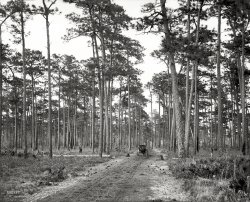
MAY CONTAIN NUTS

Search Shorpy
SHORPY ART

Framed or unframed, desk size to sofa size, printed by us in Arizona and Alabama since 2007. Explore now.
Join and Share
Ad-Free Shorpy
Shorpy is funded by you. Patreon contributors get an ad-free experience.
Learn more.

Recent comments
- Details, Details
- What's that building to the left of the tower?
- Coal Barges
- Bromo-Seltzer
- Inner harbor
- The Basin
- What a headache!
- Giant stepladder?
- Baldwin 62303
- Baldwin VO-1000
- Cold
- No expense spared
- Tough Guys
- Lost in Toyland
- And without gloves
- If I were a blindfolded time traveler
- Smoke Consumer Also Cooks
- Oh that stove!
- Possibly still there?
- What?!?
- $100 Reward
- Freeze Frame
- Texas Flyer wanted
- Just a Year Too Soon
- WWII -- Replacing men with women at the railroad crossing.
- Yes, Icing
- You kids drive me nuts!
- NOT An Easy Job
- I wonder
- Just add window boxes
Member Photos
The Shorpy
Print Emporium
Print Emporium
Search Shorpy
Search results -- 30 results per page
- All You Can Eat: 1894
- ... whose bank accounts are more flourishing than their family trees, literally seem to stagger under the weight of their jewels. …
... Posted by Dave - 05/02/2015 - 6:02pm -
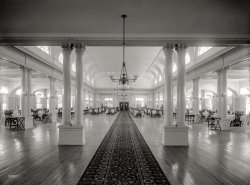
- Oaks Aplenty: 1904
- ... photo has more vines coiling around it than I have seen on trees in river bottom lands.
Assumptions I remember being in houses very ... Posted by Dave - 05/06/2013 - 10:05pm -
![Oaks Aplenty: 1904 Circa 1904. "Daytona, Florida -- Magnolia Avenue." Where oaks and palms abound. 8x10 inch glass negative, Detroit Publishing Co. View full size.
Stuffy Victorian in FlaFunny how the Northerners imported their same housing styles to the deep south without realizing how impractical they were in so far as dealing with the natural local climates. The oppressive heat and humidity in summer must have made those upper floors a veritable steam bath. I also imagine the ornate woodwork and paint alone on the exterior of these homes would have suffered in no time. Not to mention a termite's dreamland.
[Northerners wouldn't have been using their Florida homes in the summer. -tterrace]
A few old oaksSurvive along Magnolia Avenue but there seems to be no trace of any of these grand houses today. A perusal of Google Street View shows many of the flat ranch house style of the 1960s and one might wonder whether the severe visit of Hurricane Donna in 1960 eliminated or damaged those lovely structures.
Au contraire!To catch any hint of a breeze double hung windows opened on top on the second and third floors (you can clearly see this on the white house in the middle), open dormer windows, and likely transoms over interior doors, with at least one large open stairway for stack effect, make this design as practical as any for the climate (short of an open treehouse-type). People now don't seem to realize that windows are for ventilation, not just venues for "window treatments", and that high ceilings (and multiple stories) really help in hot climates. Having owned a foursquare in a climate with summers and winters, I'd say they are more practical for hot climates than cold, if you don't depend on the typical American oversized HVAC.
Tree wrapThat tree in the middle of the photo has more vines coiling around it than I have seen on trees in river bottom lands.
AssumptionsI remember being in houses very much like this when I was small. In hot weather they were great, the huge roof structures kept the hot roofs away from the ceiling, and the tall ceilings and windows let hot air rise and escape.
The biggest issue by far? No screens, and therefore flies and bats. Flies love horse dung!
Partially screenedScreens are obvious on the near house, over the guy in the rocker, and the screened washing porch in the next house. They do seem to be missing on some of the open windows in that house, though.
(The Gallery, DPC, Florida)](https://www.shorpy.com/files/images/SHORPY_4a11749a.thumbnail.jpg)
- Chicken Inn: 1937
- ... feeling a late summer breeze of fresh air wafting off the trees.
Mattresses Now. So you can sleep off all that southern fried ... Posted by Dave - 02/22/2017 - 2:58pm -
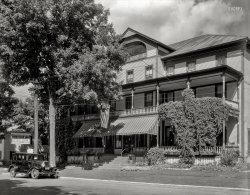
- Greenhills: 1938
- ... also pasted on. You can see something of an edge over the trees and the firetruck's front.
[You're right. The original is below. - ... Posted by Dave - 07/05/2009 - 2:11am -
![Greenhills: 1938 October 1938. Fire station at Greenhills, Ohio, a planned community built by the federal government (Suburban Division of the Resettlement Administration) during the Depression. The image, scanned from a print, is a composite, with the utility pole and fire alarm superimposed; the asphalt was retouched with an airbrush. View full size. The fire station photo is by John Vachon.
Why manipulation?I think I would have liked the original photo better. The depth of field is unnatural, the pole seems to be a hazard to vehicles coming out of the fire station and who needs a remote fire alarm right in front of a fire station?
Who did the (digital?) doctoring and why?
[This would have been done for something like a WPA poster or fire safety exhibit (it was cropped to be two feet tall -- see below). The print is over 60 years old, so it's not digitally doctored. - Dave]
Fake sky too?It appears that the sky was also pasted on. You can see something of an edge over the trees and the firetruck's front.
[You're right. The original is below. - Dave]
Gotta love those Gamewell boxesSome towns still use the old style Gamewell alarm boxes. When our department did away with them they were sold as scrap to some guy who bid on them. He turned around and sold them on eBay for a small fortune. For folks who still use a landline they can be wired up with a phone line and installed in the back yard with a phone inside.
(The Gallery, Cars, Trucks, Buses, Great Depression)](https://www.shorpy.com/files/images/8e04462u.thumbnail.jpg)
- Souvenirs & Curios: 1905
- ... siding is made of tree bark shingles, probably from poplar trees, as its bark is among the easiest to work with.
Mexican Souvenirs? ... Posted by Dave - 07/28/2014 - 11:12am -
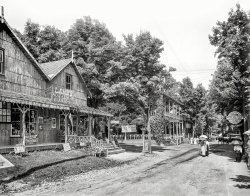
- FAPEX: 1961
- ... those small ads in magazines to order seed for "miniature trees." Gullible me ordered the things. Hey, what did I know about bonsai? ... Posted by tterrace - 06/24/2009 - 5:18pm -
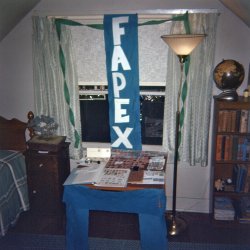
- Bedcast: 1922
- ... tornado aftermath, but was informed the bedsprings in the trees were TV antennas.
The look in his eyes says "I can't wait for ... Posted by Dave - 08/10/2013 - 1:04pm -
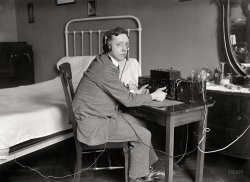
- The Ford Store: 1926
- ... head rotary mower, and trimmers to square up the orange trees for harvest time. Very distinct sound, so I can always tell when he is ... Posted by Dave - 08/26/2014 - 12:33pm -
![The Ford Store: 1926 Washington, D.C., in 1926. "Robey Motor Co. -- 1429 L Street." As long as we're downtown, let's pick up a tractor. National Photo glass negative. View full size.
Tin Lizzie's Waning Days1926 was the last full year of the Model T's production run. May 26, 1927 was the last day of production. Its successor the Model A wasn't produced until October 20, 1927 (and not sold until December 2), leaving a bit of interregnum.
What's a "Fordson"?It's listed on the roof sign along with Ford and Lincoln, but it's totally unknown to me. Auto experts: can you help?
[An inscrutable mystery is what it is. What a puzzler! - Dave]
Fordson TractorsThat thing sitting in front of the building is a Fordson.
My neighbor uses a Fordsonin his citrus grove - I think it is a 3-cylinder diesel version. He uses several different implements running off the power take off (PTO), such as a disc harrow, towed twin head rotary mower, and trimmers to square up the orange trees for harvest time. Very distinct sound, so I can always tell when he is at work in the grove.
Fatal FordsonMy first attempt at siphoning gas was from the late '40s blue-colored Fordson on our family farm. I accidentally swallowed a bit of the gas and my brother, my cousins, and I were all convinced I would die later in the afternoon. I was burping up gas fumes the rest of the day but that was the only bad effect.
That was in 1964 and I still get the shivers when I hear or read the word "Fordson."
(The Gallery, Cars, Trucks, Buses, D.C., Natl Photo)](https://www.shorpy.com/files/images/SHORPY-16097u.thumbnail.jpg)
- Place d'Armes: 1916
- ... to accomplish my mission; even if all of Montreal’s trees should transform into as many Iroquois."
Great Old Stuff The ... Posted by Dave - 01/22/2018 - 9:37am -
![Place d'Armes: 1916 Circa 1916. "Place d'Armes and Notre Dame Cathedral, Montreal, Quebec." 8x10 inch dry plate glass negative, Detroit Publishing Company. View full size.
Place d'ArmesThe statue, lower center, erected in 1895, is of the founder of Montreal, Paul de Chomedey, Sieur de Maisonneuve. On the nearby Bank of Montreal is a plaque which reads: "Near this square afterwards named La Place d’Armes the founders of Ville-Marie first encountered the Iroquois whom they defeated, Paul de Chomedey de Maisonneuve killing the chief with his own hands. March 1644.” At the base of the monument itself is another plaque with a more shocking message by de Maisonneuve: "Il est de mon honneur d'accomplir ma mission. Tous les arbres de l'île de Montréal devraient-ils se changer en autant d'Iroquois." Which translates: "Upon my honour I am bound to accomplish my mission; even if all of Montreal’s trees should transform into as many Iroquois."
Great Old StuffThe building slightly visible on the extreme left -- you can just make out part of the clock tower -- was built by the New York Life Insurance Company in 1887 and at 8 floors was the tallest building in Montreal when it opened. The building next to Notre Dame is the Saint-Sulpice Seminary, part of which dates back to 1684. And in the middle of the square we find the statue of Paul Chomedy de Maisonneuve erected in 1895. All of these, and much more, are still there.
BasilicaAt the time it was built there weren't very many stone-carvers in Montréal, so the decoration is a bit plain. These days the cathedral is Mary, Queen of the World, which is a short distance away.
Radio or Lightning?Given the year, I am assuming the towers on top of the spires are lightning rods, not radio towers. Eh?
[Wireless telegraphy masts started being placed atop tall urban buildings before the turn of the century. -tterrace]
A striking differenceExcept for the addition of a small Art Deco highrise to the left and a massive 1960s block on the right, Place d'Armes has been preserved pretty well. But there's been one striking addition: the the concrete pavement of this photo has long since been replaced by cobblestones, in order to bolster the square's quaintness. Nowadays it's a cliche to rave at how "European" Place d'Armes looks.
It's a bit sad to contrast this view with some of the other photoscapes you see on Shorpy, especially of cities such as Cleveland and Buffalo. A hundred years ago the cityscapes weren't that different. I would argue that a lot of the American cities were even more fantastic than Place d'Armes. The trajectories of these cities echoed each other - although Montreal hasn't had the same economic trouble as the Midwest, this area of the city also fell into hard times and was pretty decrepit during the mid-century. But the revitalizers in the Midwest and Montreal had different ideas, and that's made the difference. In Montreal, they installed cobblestones; in Buffalo they built parking lots, and their former downtown is almost abandoned.
(The Gallery, DPC, Streetcars)](https://www.shorpy.com/files/images/SHORPY-4a24892a.thumbnail.jpg)
- New York Avenue: 1905
- ... York Avenue." Looking a little like New England with palm trees. 8x10 inch glass negative. View full size.
Florida Foliage ... state tree. -Dave]
Palmless I see no palms trees. Who can identify the fronded vegetation?
(The Gallery, DPC, Florida) ... Posted by Dave - 05/12/2014 - 12:02pm -
![New York Avenue: 1905 DeLand, Florida, circa 1905. "New York Avenue." Looking a little like New England with palm trees. 8x10 inch glass negative. View full size.
Florida FoliageThose appear to be Palmettos.
[The bigger ones (and maybe the others) are young sabal palms -- Florida's state tree. -Dave]
PalmlessI see no palms trees. Who can identify the fronded vegetation?
(The Gallery, DPC, Florida)](https://www.shorpy.com/files/images/SHORPY-4a12558a.thumbnail.jpg)
- Piles to New Castle: 1906
- ... me guess That lovely wood frame house seen through the trees was really a small hotel which burned to the ground a few years after ... Posted by Dave - 01/12/2021 - 1:11pm -
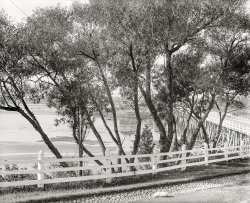
- March on Washington: 1963
- ... the formerly treeless block is now lined with sidewalk trees, a simple change that greatly softens 1963's stark appearance.
No. ... Posted by Dave - 08/24/2013 - 1:25pm -
![March on Washington: 1963 August 1963. "New York. Sidewalk sign outside the March on Washington headquarters building, 170 W. 130th Street." Photo by Werner Wolff for U.S. News & World Report. View full size.
How Can?How can marching around and making speeches create jobs?
[By leading to passage of the Civil Rights Act of 1964, specifically Title VII. - Dave]
Memorable dateOn that date, the 18-year-old girl (who was to become my wife 15 years later) headed from NYC to Washington with her grandfather, and had the incredible experience of hearing Martin Luther King, Jr., give his "I Have a Dream" speech. In her memory (she died in 1984), I will be at the Lincoln Memorial this Wednesday.
Calendar sync!90 years anniversary, and Wednesday is again 8/28!
[Um... next Wednesday will be the 50th anniversary of the march. -tterrace]
Uh - typo?!? Or short on coffee...
Why Arbor Day is a terrific ideaBleak and uninviting in 1963, this block of West 130th looks immeasurably nicer today even though most of the buildings are largely unchanged on the outside. The big difference is that the formerly treeless block is now lined with sidewalk trees, a simple change that greatly softens 1963's stark appearance.
No. 170 is still there, as are the buildings just past it with the interesting brownstone stoops. Several of the buildings across the street were torn down and there's now a paved parking area on their site.
View Larger Map
Bill Landau: thanks for your posting.Curious how a scant 5 lines can indicate a whole slice of other people's lives.
Sorry for the loss of your wife: too soon, she was only 3 years older than me and it's now almost 30 years since she passed. I will be thinking of this posting on Wednesday.
(NYC)](https://www.shorpy.com/files/images/SHORPY_04560u.thumbnail.jpg)
- Picnic in the Park: 1905
- ...
Restricted view You can't see the benches for the trees.
(The Gallery, DPC, Syracuse) ... Posted by Dave - 08/21/2012 - 12:01pm -
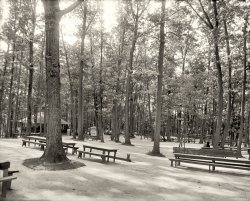
- Pensa-Cola: 1910
- ... it is from street view (with the harbor obscured by the trees):
View Larger Map
And in bird's-eye view (bottom ... Posted by Dave - 07/18/2012 - 7:02pm -
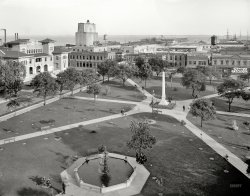
- The Emissary: 1935
- ... the Kellams The Kellams, obviously, are a family of trees... Mr. Kellam to the right, plus Missus and all the little saplings. He's ... Posted by Dave - 02/26/2015 - 8:38pm -
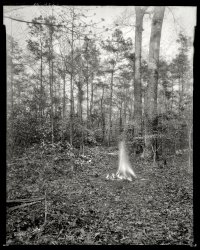
- Cameron Hill: 1864
- ... southeast looking northwest. The hill is also thick with trees on the northeast and east sides but the top overlooks the Tennessee ... Posted by Dave - 10/18/2008 - 5:57pm -
![Cameron Hill: 1864 1864. "Chattanooga, Tennessee. Adams Express office and the Crutchfield house with Cameron Hill in the distance." Photographer unknown. View full size.
Now an insurance companyCameron Hill still dominates downtown Chattanooga, but because of today's buildings it's impossible to duplicate this view, which is generally from the southeast looking northwest. The hill is also thick with trees on the northeast and east sides but the top overlooks the Tennessee River. Until a few years ago the top was residential but now an insurance company is building its headquarters up there, dominating the downtown.
READ HOUSE HOTELBRICK BUILING IN LEFT SIDE OF PICTURE IS THE READ HOUSE HOTEL. WHICH STILL IN BUSINESS IN THIS SAME LOCATION. IT'S IN A NEWER BUILDING OF COURSE. MOST OF THE TOP OF CAMERON HILL WAS USED AS FILL FOR A DOWNTOWN FREEWAY,IN THE 1960S.
NOW THE HUGE INSURANCE CO.
[MANY THANKS FOR TELEGRAM - STOP - MIGHT WANT TO CHECK THAT CAPS LOCK KEY - STOP - DAVE]
(The Gallery, Civil War, Railroads)](https://www.shorpy.com/files/images/02124u.thumbnail.jpg)
- Chop Suey Canyon (Colorized): 1916
- ... do). I tried this on the street, sidewalks, dirt, and the trees, and was fairly pleased with how they turned out. I also tried something ... Posted by scottr - 10/12/2011 - 11:20am -
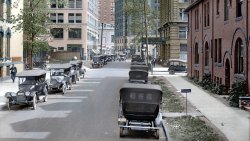
- Willard Batteries: 1947
- ... today, as is the wooden one partly visible next door. Trees obscure the view today, so you'll have to drive by in the Google street ... Posted by Dave - 05/05/2015 - 8:58pm -
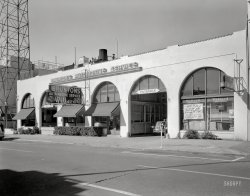
- The Patio: c. 1957
- ... warped transparency. - Dave]
All those LA palm trees that have not fallen over or been removed have gotten ridiculously high ... Posted by Mvsman - 01/13/2011 - 11:01am -
![The Patio: c. 1957 This is our backyard and patio in beautiful West Covina, CA about 1957. Mom and I are getting the BBQ set up for Dad. Those are agave and palm plants in the center of the patio, I think. The screen door leads to the living room. The window to the left of the screen door opens onto the dining room, where my family was having their Christmas dinner. View full size.
Tilt lens effectThe very archetype of a Southern California 50's backyard!
Interesting how the lens distortions at the top of the frame give this image the now wildly popular "tilt lens" or "shallow depth of field" effect that makes a full sized scene look miniature. The camera manufacturer didn't quite get that lens glued in straight.
[Another possibility: warped transparency. - Dave]
All those LA palm trees that have not fallen over or been removed have gotten ridiculously high in recent times.
MvsmanThis was the house where I spent the best part of my childhood. Thanks for your comments!
That's a new patio, too!Looks wonderful.
Palms & PatioGreat window into 50s California suburbia. I'm going to say those are iris rather than agave with the little palm in the center; agaves form a circular rosette, and those leaves appear to be in a fan formation. I see a little racing car at the edge of the patio. If you were like me, you'd forgo the patio and build a system of roads in the dirt for it. I became quite adept at conditioning dirt, either by shaving or pulverizing it, to a consistency that emulated asphalt that I'd then use to "pave" my roads. Of course, much of it wound up caked on the knees of my jeans, resulting in my leaving a trail of little hardened mud cookies if I didn't clean up thoroughly before going inside.
Lovely BlueWhat a wonderful picture. It's now my new desktop background.
Thank youThis home and neighborhood was where my fondest childhood memories took place.
(ShorpyBlog, Member Gallery)](https://www.shorpy.com/files/images/28780023_0.thumbnail.jpg)
- Throwing Shade: 1940
- ... of roadside woods, it's sad to think that such trees may become a thing of the past in the near future.
US 61, Southwest ... Posted by Dave - 05/30/2019 - 1:04pm -
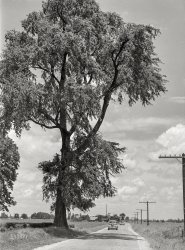
- Verdict: Delicious!
- ...
Army Buffet With the military men, the huge pine trees and pine needles for decoration, this looks like it was taken at Fort ... Posted by Dave - 04/19/2018 - 10:25am -
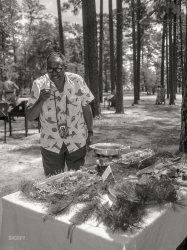
- Cozy Shack: 1939
- ... boxes in July! I'd bet the dogs are lounging under the trees we see in the background.
The definition of poverty then compared to ... Posted by Dave - 05/22/2018 - 11:19am -
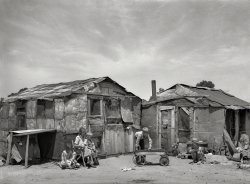
- San Francisco Briscoe: 1919
- ... beach. The curbing has changed a bit, and there are more trees than 1919-ish, but the view remains as spectacular as ever.
Very ... Posted by Dave - 01/11/2016 - 11:06pm -
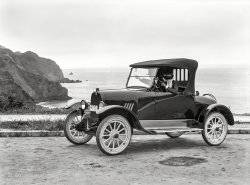
- East Battery: 1900
- ... unchanged, including the boardwalk pavers. Just the palm trees have grown. I bet the vibe you'd soak up on a walk on those original ... Posted by Dave - 12/29/2017 - 11:37pm -
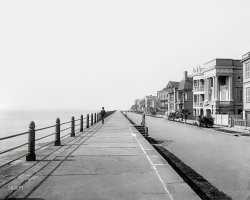
- Three-Quarter Moon: 1920
- ... chains in Golden Gate Park." Was that ice under those palm trees? Latest entry in the Shorpy File of Ephemeral Phaetons. 5x7 inch glass ... Posted by Dave - 08/02/2015 - 11:27pm -
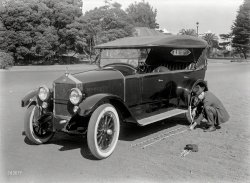
- Butter Eggs Cheese: 1926
- ... The building you can see behind the truck, through the trees, is the old Kann's department store on Pennsylvania Avenue between ... Posted by Dave - 07/08/2014 - 12:49pm -
![Butter Eggs Cheese: 1926 Washington, D.C., 1926. "Semmes Motor Co. National City Dairy truck." A dented Dodge. National Photo Company Collection glass negative. View full size.
Looking along 8th StreetWith the Old Patent Office (now the National Portrait Gallery) at Eighth & F Streets NW in the background.
[It could also be the identical north facade at Eighth and G but I think you're right, as this photo seems to have been taken near the Center Market at Eighth and Pennsylvania. Kudos for correctly identifying the building as the Patent Office and not the Treasury. - Dave]
Sleek, manApart from the damaged fender, this vehicle has a sleek look accentuated further by that spare tire. Fabulous material for a hot rod in later years.
The ViewYes, Odie is right. I'm sitting a couple of blocks from there right now. The building you can see behind the truck, through the trees, is the old Kann's department store on Pennsylvania Avenue between Seventh and Eighth streets.
(The Gallery, Cars, Trucks, Buses, D.C., Natl Photo)](https://www.shorpy.com/files/images/32446u.thumbnail.jpg)
- Inn of the Four Turrets: 1900
- ... undernourished horses from eating the bark and killing the trees. Alas, all the trees are gone today.
(The Gallery, DPC) ... Posted by Dave - 05/15/2015 - 9:34am -
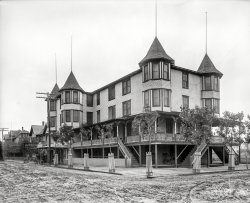
- Company B (Colorized): 1864
- ... This one looked like the job would be easy, but the trees were very hard to do because the trunks blend so well with the boughs. ... Posted by Fredric Falcon - 01/06/2010 - 2:48pm -
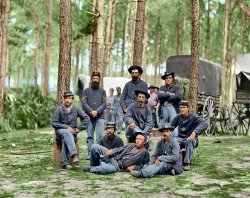
- Mt. Tam: 1910
- ... view is pretty much out of the question due to so many trees now lining the streets. Here is about where I believe the photo was ... Posted by Dave - 12/13/2014 - 12:51pm -
![Mt. Tam: 1910 Marin County, California, circa 1910. "Scenic view of Mount Tamalpais." From an Indian name meaning "west hill." 8x10 inch glass negative. View full size.
I rememberI used to live in the Mill Valley area in the '70s. I've been over and around Mt Tam many times, both by car and motorcycle. The motorcycle was much more fun. I remember narrow roads and lots and lots of houses. Some days it near impossible to get over it. When did they put the small amphitheater on top?
Does anybody remember doing a motorcycle ride from Mill Valley around Mt Tam to Inverness? I think it was nicknamed the "Sunday Morning Run."
ColorizedA colorized version with lens flair.
[Or, as the ancients called it, "lens flare." Beautiful! - Dave]
Sidney B Cushing AmphitheaterThe story in a nutshell: Begun in 1933, it holds 4,000 people.
I'm trying to place where this shot was taken -- seems to be from the ridge over Tam Valley, pretty much from the south, before Mill Valley got built up. I lived in MV from 1957 to 1998.
MY mountain. Where I went directly after getting my driver's license. Where I had my first kiss. Where I went to be alone, or to be with friends.
And yes, the damn motorcycles do their run over it every Sunday morning; they used to wake me up as they rode in packs up Highway One by my house. If only they had mufflers!
This is about as close as I can estimate the location.I think getting any kind of street level view is pretty much out of the question due to so many trees now lining the streets. Here is about where I believe the photo was taken.
(The Gallery, Landscapes, W. Stanley)](https://www.shorpy.com/files/images/SHORPY-165-02B.thumbnail.jpg)
- Florida Pines: 1905
- ... With their long skinny trunks and heavier tops, pine trees have a tendency to come crashing down during storms. Hurricane Donna's ... Posted by Dave - 07/06/2015 - 5:26pm -
